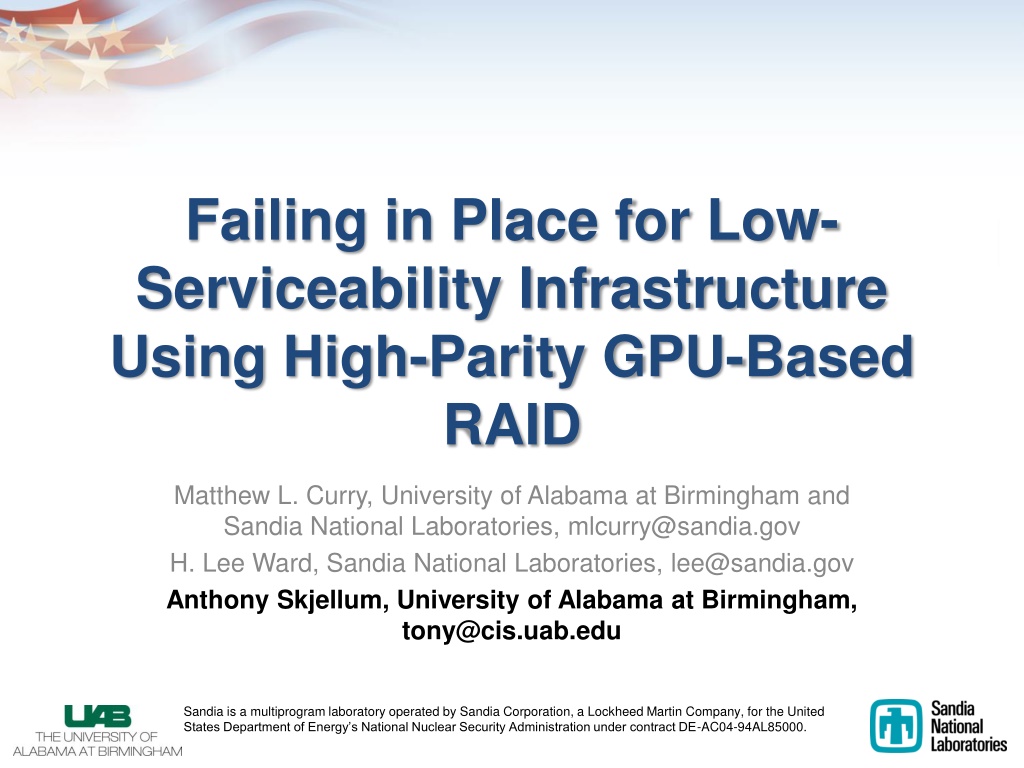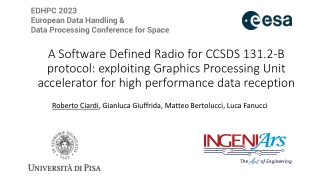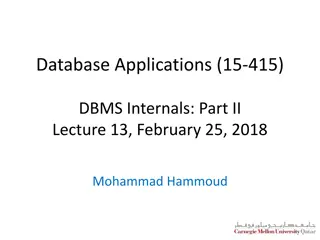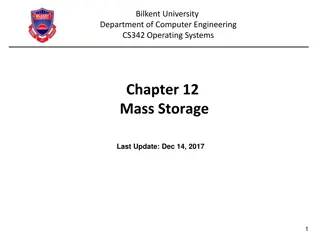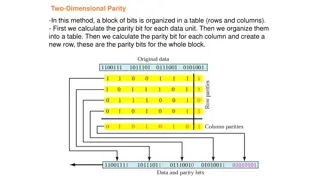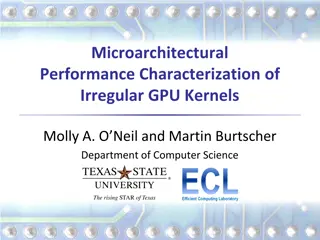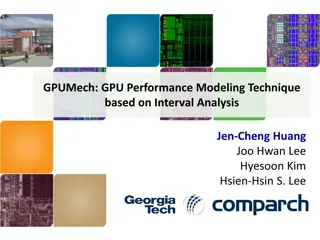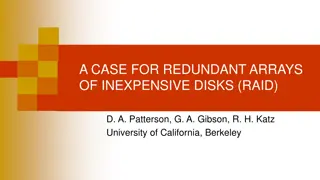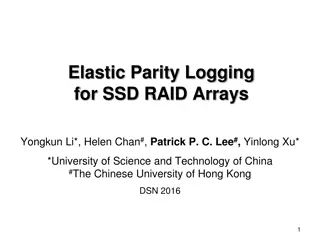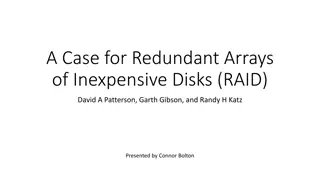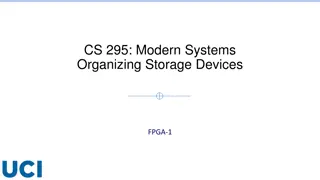Enhancing Data Storage Reliability with High-Parity GPU-Based RAID
The research discusses the challenges faced by traditional RAID systems in maintaining data reliability and proposes a solution using High-Parity GPU-Based RAID. It highlights the limitations of current technologies in fault tolerance, the inaccuracies in disk failure statistics, and the significance of dealing with unrecoverable read errors. The inadequacy of hot spares under load is addressed along with a detailed solution incorporating Reed-Solomon Coding for improved fault tolerance. This advanced RAID configuration involves active participation of spare disks, reducing the vulnerability window and enhancing long-term data loss prevention.
Download Presentation

Please find below an Image/Link to download the presentation.
The content on the website is provided AS IS for your information and personal use only. It may not be sold, licensed, or shared on other websites without obtaining consent from the author. Download presentation by click this link. If you encounter any issues during the download, it is possible that the publisher has removed the file from their server.
E N D
Presentation Transcript
Failing in Place for Low- Serviceability Infrastructure Using High-Parity GPU-Based RAID Matthew L. Curry, University of Alabama at Birmingham and Sandia National Laboratories, mlcurry@sandia.gov H. Lee Ward, Sandia National Laboratories, lee@sandia.gov Anthony Skjellum, University of Alabama at Birmingham, tony@cis.uab.edu Sandia is a multiprogram laboratory operated by Sandia Corporation, a Lockheed Martin Company, for the United States Department of Energy s National Nuclear Security Administration under contract DE-AC04-94AL85000.
Introduction RAID increases speed and reliability of disk arrays Mainstream technology limits fault tolerance to two arbitrary failed disks in volume at a time (RAID 6) Always-on and busy systems that do not have service periods are at increased risk of failure Hot spares can decrease rebuild time, but leave installations vulnerable for days at a time High-parity GPU-based RAID can decrease long-term risk of data loss 2
Motivation: Inaccurate Disk Failure Statistics Mean Time To Data Loss of RAID often assumes manufacturer statistics are accurate Disks are 2-10x more likely to fail than manufacturers estimate* Estimates assume low replacement latency and fast rebuilds Without load *Bianca Schroeder and Garth A. Gibson. Disk failures in the real world: What does an MTTF of 1,000,000 hours mean to you? In Proceedings of the 5th USENIX Conference on File and Storage Technologies, Berkeley, CA, USA, 2007. USENIX Association. 3
Motivation: Unrecoverable Read Errors 1 Probability of Success (No 0.9 0.8 0.7 0.6 Error) 0.5 0.4 0.3 0.2 0.1 0 0 5 10 15 20 25 30 35 40 45 50 55 60 65 70 75 80 85 90 95 100 Terabytes Read BER = 10^-14 BER = 10^-15 BER = 10^-16 4
Result: Hot Spares Are Inadequate Under Load 0 100 200 300 1.E+00 Probability of Data Loss Within 1.E-01 RAID 5+0 (4 sets) Ten Years RAID 6+0 (4 sets) 1.E-02 RAID 1+0 (3-way replication) 1.E-03 1.E-04 Data Capacity (TB, using 2TB Disks) MTTR = One Week, MTTF = 100,000 Hours, Lifetime = 10 years 5
Solution: High-Parity RAID Use Reed-Solomon Coding to provide much higher fault tolerance Configure array to tolerate failure of any m disks, where m can vary widely Analogue: RAID 5 has m=1, RAID 6 has m=2, RAID 6+0 also has m=2 Spare disks, instead of remaining idle, participate actively in array, eliminating window of vulnerability This is very computationally expensive k+m RAID, where k is number of data blocks per stripe and m is number of parity blocks per stripe, requires O(m) operations per byte written Table lookups, so no vector-based parallelism with x86/x86-64 Failed disks in array operate in degraded mode, which requires the same computational load for reads as writes 6
Use GPUs to Provide Fast RAID Computations Reed-Solomon coding accesses a look-up table NVIDIA CUDA architecture supplies several banks of memory, accessible in parallel 1.82 look-ups per cycle per SM on average GeForce GTX 285 has 30 SMs, so can satisfy 55 look-ups per cycle per device Compare to one per core in x86 processors Compute Core Shared Memory Bank 7
Performance: GeForce GTX 285 vs. Intel Extreme Edition 975 GPU capable of providing high bandwidth at 6x-10x CPU speeds New memory layout and matrix generation algorithm for Reed-Solomon yields equivalent write and degraded read performance 5000 4500 4000 Coding Throughput (MB/s) 3500 GPU m=2 3000 GPU m=3 2500 GPU m=4 2000 CPU m=2 1500 CPU m=3 CPU m=4 1000 500 0 2 6 Number of Data Buffers 10 14 18 22 26 30 8
A User Space RAID Architecture and Data Flow GPU computing facilities are inaccessible from kernel space Provide I/O stack components in user space, accessible via iSCSI Accessible via loopback interface for direct- attached storage, as in this study Alternative: Micro-driver
Performance Results Linux MD, RAID 0 RAID Type GPU +4 Write Read GPU +3 GPU +2 0 100 200 Throughput (MB/s) 300 400 500 600 10 GB streaming read/write operations to a 16- disk array Volumes mounted over loopback interface stgt version used is bottleneck, later versions have higher performance 10
Advance: GPU-Based RAID Prototype for general-purpose RAID Arbitrary parity High-speed read verification High-parity configuration for initial hardware deployments Guard against batch-correlated failures Flexibility not available with hardware RAID Lower-bandwidth higher-reliability distributed data stores 11
Future Work UAB Data intensive active storage computation apps Computation, Compression within the storage stack NSF-funded AS/RAID testbed (.5 Petabyte) Multi-level RAID architecture, failover, trade studies Actually use the storage (e.g., ~200TB of 500TB) Sandia Active/active failover configurations Multi-level RAID architectures Encryption within the storage stack Commercialization 12
Conclusions RAID reliability is increasingly related to BER Window of vulnerability during rebuild is dangerous, needs to be eliminated if system stays busy 24x7 Hot spares are inadequate because of elongated rebuild times under load High-parity GPU RAID can eliminate window of vulnerability while not harming performance for streaming workload Fast writes and degraded reads enabled by GPU make this feasible 13
